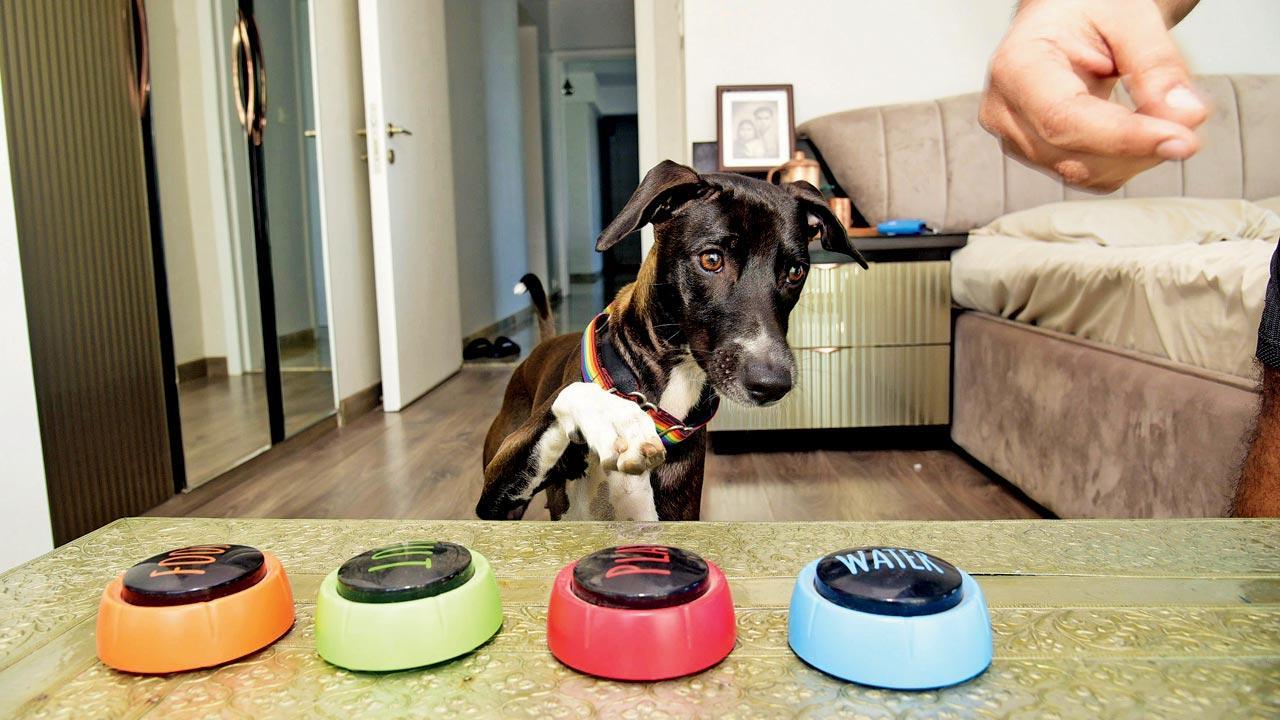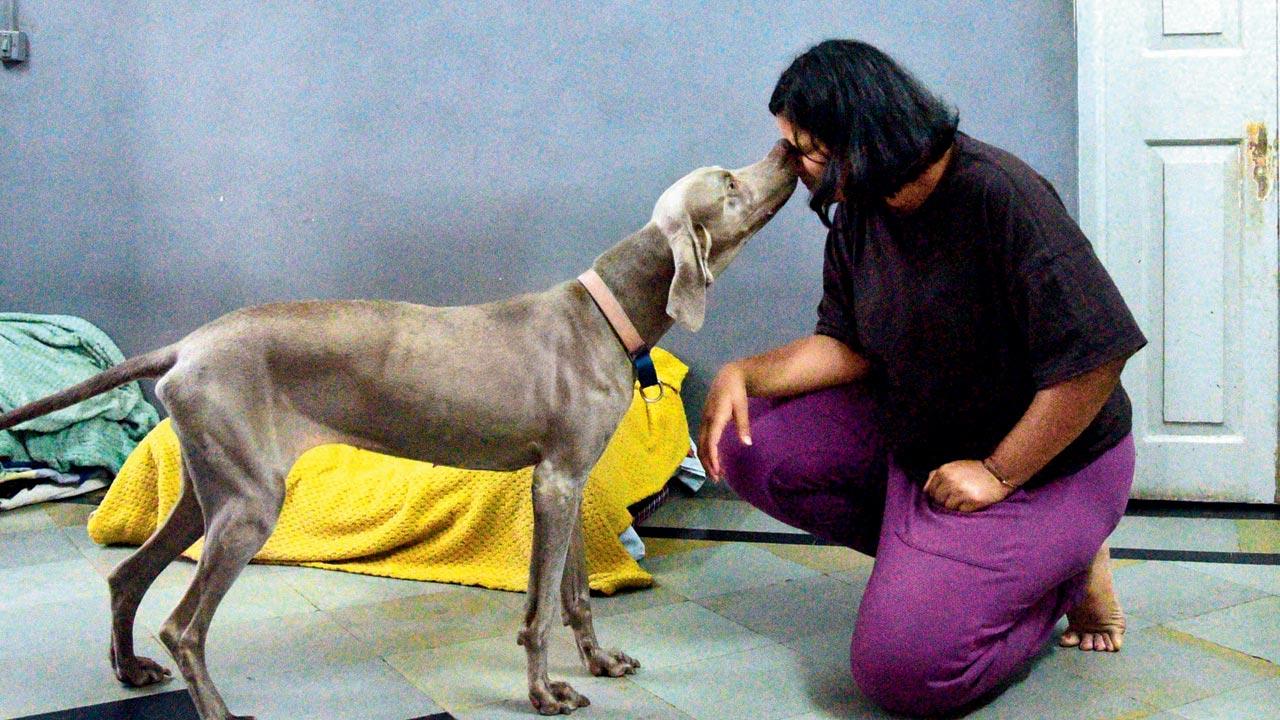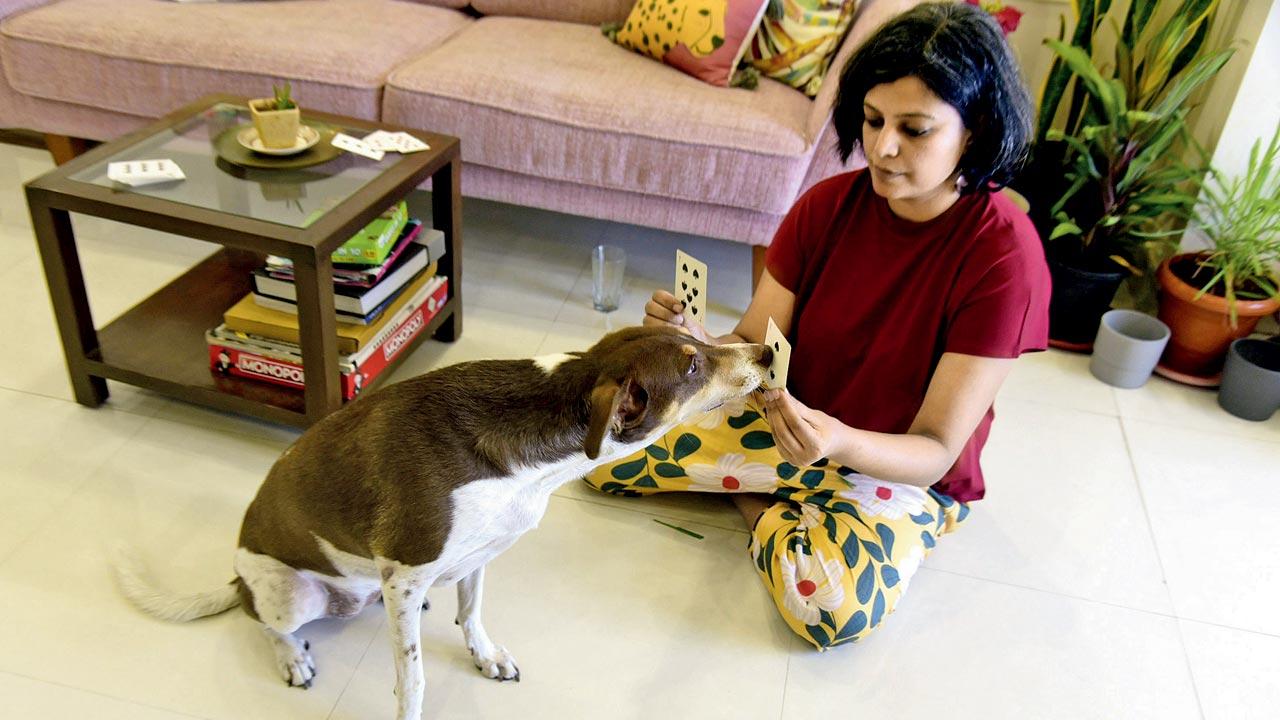They are! We introduce you to three pets and residents of Mumbai who would ace Mensa tests

Quincy is learning to push Stranger on the speech buttons instead of barking at new people who come to the door. Pics/Atul Kamble
Every pet parent thinks their dog is smart; that she understands everything they say. While that may be true, some dogs are just like the neighbourhood Kulkarnyacha Siddhesh—better and faster at everything. And unimaginably so.
Meet Gaya (short for Gayatri), Kiss and Quincy—dogs who can tell apart colours, numbers, and communicate with their parents succinctly.
It became clear that Gaya was exceptionally intelligent when Deepti Rao began her basic obedience training. “She would make connections easily,” says the canine behaviourist and entrepreneur. Teaching a dog is to guide them into co-relating the sound of a word with the corresponding action. “She would learn complex cues such as Go-to-Bed in three to six seconds.” Go-to-Bed involves the dog going to an assigned place, relaxing over there and not moving until s/he is told to. It requires him/her to link three commands: Go, Down, Settle. It would take a dog of average intelligence at least 15 minutes to get it right.
 Kiss’s patience draws neuro-divergent kids out of their shell
Kiss’s patience draws neuro-divergent kids out of their shell
“She would also get bored fast, and be reluctant to repeat it,” says the founder of canine enrichment toy-making firm, For the Love of Dog. “She was very communicative. If I asked her which treat she wanted, she would smell both, and then nose the one she wanted. It could also be neither of the two, and then I would have to give her a third option.” On walks, Gaya would steer the route by standing stationary, until Rao asked, “Do you want to go to P [parking]?”
So, the first thing Rao, and her partner advertising executive Joshua Thomas, taught her was Yes and No. Yes, being the right palm; No, the left. “She would punch Yes with her nose swiftly, excitedly and multiple times,” says the Parel resident, “Nos are more hesitant, and not used often; she prefers to look away.” Now Rao could ask her, ‘Shall we go?’ to leave a stressful situation, or ask whether it was okay to pick her up.
By the time Gaya turned two, the streetie expressed disdain for run-of-the-mill commands such as Shake Hand, by turning or walking away. Rao had to invent new games to keep her stimulated and out of trouble. She had swatches of coloured fleece lying around, and began teaching Gaya to distinguish them.
 Pradnya Hattiangadi found that violent training methods had sent Kiss into a shell. A softer tone, gentle touches and lots of rewards made this once “untrainable” dog, a workaholic. Pics/Pradeep Dhivar
Pradnya Hattiangadi found that violent training methods had sent Kiss into a shell. A softer tone, gentle touches and lots of rewards made this once “untrainable” dog, a workaholic. Pics/Pradeep Dhivar
“I started with blue and yellow because studies say dogs see these two more vividly,” says Rao, “and would hold the corresponding patch closer to her so that she could associate quickly. When she nosed it correctly, she was rewarded. We progressed to red, pink, green, orange, grey and brown within three days. To eliminate any bias at my end, I also pasted swatches on to thick paper so that I could not see the colour.” This also put to rest the theory that dogs are colour blind. “I expected her to have trouble with colours that are close together—like red and pink, but she didn’t.”
Rao moved on to numbers. She would hold up corresponding fingers in each hand, and once Gaya associated the words with the numbers, Rao began asking her ‘which is bigger or smaller’. “She had to understand the concept,” she says, “and once she did, we tried it with playing cards. Holding up, say a deuce and a 10, and ask her which is bigger.” Gaya knew. At three, Gaya could tell a round lid of a takeaway box apart from a square one.
“Motivating her can be hard,” says Rao. Like any parent, she had to meet Gaya halfway—be patient, not push her too far and find rewards that held value for the dog. Blades of grass did the trick.
 Gaya can tell shapes apart, and also guess which number is bigger or smaller on playing cards
Gaya can tell shapes apart, and also guess which number is bigger or smaller on playing cards
Next on the curriculum is teaching her speech buttons. Primates in captivity have shown great success with this communication tool. It involves assigning a button a word, like Ouch and recording that in the human’s voice. Next comes teaching the dog to associate Ouch with illness or pain. Eventually, it means Gaya can press Ouch to tell Rao she is unwell or in pain, eliminating guesswork.
Kiss, the Weimaraner, was once deemed so dumb that she could not be trained. This came from those using crude and archaic methods of dog training—punishment instead of reward, choke chains for harsh correction instead of guidance.
So, when she was bequeathed to canine behaviourist Pradnya Hattiangadi, Kiss was an unresponsive four-year-old, disinterested in people or the environment. It’s a state described as shut down when a living being, in the face of consistent and harsh criticism, stops responding to anything convinced s/he can do nothing right.
That was then.
For five years, Kiss has been working a few times a week with children with developmental difficulties and special abilities. She patiently stands (and sits) through heavy handling, awkward movements and the chaos of little humans, without barking or pulling on the leash to leave. All it took was gentler handling, softer tones and touch on some parts of the body to bring about the transformation.
Her hyper-sensitive nature caught the smallest of twitches. “She reads emotional feedback minutely,” explains Hattiangadi. “She can read gestures, tactile and emotional cues, and tone of voice.”
Kiss can work up to two-and-a-half hours, three to four times a week, without complaints. An average people-pleasing Labrador would say, “Itne treat mein itnaich milega” in 40 minutes, twice a week.
“She has a lot of patience,” says the Matunga resident. “And can work with a diverse audience—neurodivergent children, those with disabilities, curious toddlers, boisterous teenagers and senior citizens. She also takes instructions in different environments easily.”
Kiss’s reluctance to engage guides angry children to calm communication. “One boy would resort to physical force to be heard,” explains Hattiangadi. “Initially, he tried it with Kiss, but Kiss wouldn’t react. Slowly they became friends and would share his dabba. When he found that Kiss could understand him if he spoke softly, the boy started communicating without anger with people as well.”
If a child is wary, Hattiangadi will turn Kiss’s face away, offering the silver-grey bum for petting instead. If her human misses the cue, Kiss does this intuitively. With children who have nervous, angry or defensive energy, she begins jumping and skipping, diverting their energy to physical play. “She even throws a box of treats in their direction to invite involvement.”
Kiss also has bodily kinesthetic intelligence, a quality possessed by acrobats, gymnasts and dancers: The ability to control one’s body movements—spins, weaving between legs, jumping through hoops, crawls, etc. “She loves tricks that make her think and link cues together,” says Hattiangadi. “Like a circuit of weave, jump and crawl.”
This has come in handy while establishing an exercise regimen to keep her spry. Canine physical fitness coach Pranita Balar has taught her concentrated exercise to retain muscle strength, and stretch out weak muscles.
Kiss has just turned 11, and her sight and hearing are fading. She can no longer hear from afar or see hand gestures, so Hattiangadi is teaching an old dog new tricks. “We are working on touch commands,” she says. A small tap on the head indicates sit. A stroke on the back is for turning around, and tapping the feet a certain way to tell her to lie down. But Kiss still works. “We say this as a joke, but I think it’s true: One Kiss can heal the world,” says her human.
At two months of age, Quincy had figured how to push the cardboard carton containing her and her sibling on its side, and escape. After that, her parents—Anushree Lokhande and Moulik Shah—had a hard time containing her. The other indicator was the speed at which she picked up basic obedience commands. “She responded to hand signals promptly and at last count, knew about 40 commands,” says Shah about their 2.5-year-old streetie.
Like many of her breed, Quincy is very cued into human body language and facial expressions—a skill that would keep her safe on the streets. She pays close attention when her humans speak to her, tilting her head to catch the tone and intonation of what they are saying. “She recognises the purpose of items of clothing,” says Lokhande. “If we dress up for the office or a party, she won’t come to us asking to be taken along. If you mention familiar words or names in passing, she will look at us to gauge what’s happening.”
As a streetie, her instinct to guard is strong, and the couple is trying to get her to communicate this softly instead of barking. “We bought four pre-programmed buttons for fun,” says Shah, who lives in Prabhadevi. “They’re for food (treats), play, water (ice) and outside (walk). She took a while to get the hang of them, but soon, the food button ran out of battery!” Now, the psychotherapist and diamond trader are trying to teach her to say ‘Pet Me’ and ‘Stranger’.
“Quincy isn’t a big fan of physical affection, so we are teaching her to use the button to help her communicate that desire with us,” says Shah. This will give Quincy the agency of communicating who can engage with her, laying to rest fear of cuddles and hugs, which can be intimidating for dogs. Essentially, she gains consent.
The same thought process is being put in action to route her response to doorbells. “Quincy’s self-decreed duty in the house is that of being a guard dog,” says Lokhande. “So, if there’s any activity outside the main door, she will bark to alert us. We are trying to get her to transition to the ‘stranger’ button instead.”
 Subscribe today by clicking the link and stay updated with the latest news!" Click here!
Subscribe today by clicking the link and stay updated with the latest news!" Click here!








